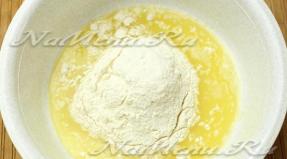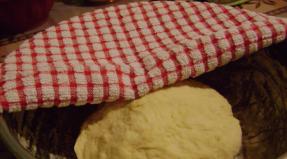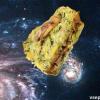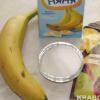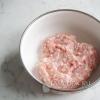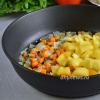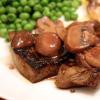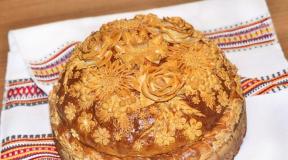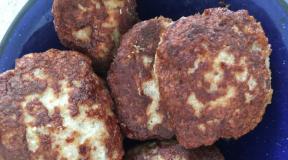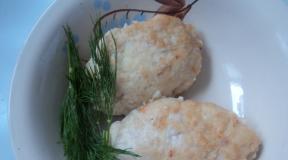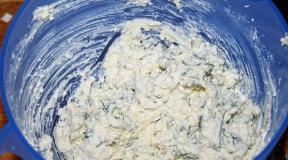How to work properly with pastry mastic. Beautiful approach
Sugar mastic cakes are becoming more and more popular today. Thanks to the variety of confectionery tools and ingredients, now not only professionals, but also amateurs can try their hand at this art. But do not expect that "unearthly beauty" will come out the first time: the art of working with mastic, like any other art, must be learned. Each business has its own secrets and tricks, which can be easily reached by trial and error. So that you can quickly and efficiently learn how to work with sugar mastic, we have prepared a selection of useful tips for you.
How to roll sugar mastic correctly?
There are several ways to roll out:
- On a surface sprinkled with starch or powdered sugar.
- Between sheets of polyethylene, oiled with vegetable oil.
- On a rug with a non-stick surface.
The most famous method is rolling the mastic on a surface sprinkled with powder or starch. The only difficulty of the first method is that the rolled layer of sugar mastic must be constantly rotated during rolling so that it does not stick to the surface. If you choose the second option, you will need to remove the top layer of polyethylene from the rolled mastic, turn the layer over, evenly cover the cake with it, and only then separate the second layer of polyethylene. However, thin polyethylene (for example, cling film) is poorly suited for our purposes: here you need to use something thicker and more substantial, like a film for greenhouses.
What to do if the mastic tears or cracks all the time?
Sugar mastic is not designed for very fine sheeting. The thickness of the layer should be approximately 2-3 mm (thicker is also not desirable). Thinly rolled mastic has its drawbacks: firstly, it can tear during the coating of the cake, and secondly, all defects and irregularities of your culinary masterpiece will be visible under it (for example, layers of cake and pieces of cream). All errors must be corrected before you decide to cover the cake with sugar paste. The surface of the cake should be smooth, without protruding edges and creases.
It is also possible that when kneading the mastic you used “coarse” powdered sugar, in which whole crystals of sugar come across. There is nothing you can do about it: such mastic will tear even when rolling.
If the layer that covered the cake nevertheless broke at the most crucial moment, do not despair. The best way to restore the cake is to remove the mastic layer and re-coat it. If the first action is impossible, then seams, patches and other shortcomings can be "ironed out" with the help of a pastry iron and vegetable fat. Apply grease to the damaged surface and flatten the cake with an iron until the surface is perfectly flat. And if air bubbles suddenly appear under a layer of mastic, try to pierce them with a needle, and then carefully smooth out the "holes".
How to properly cover the cake with sugar paste?
In order to avoid ugly folds on the sides of the cake, you need the following: roll out the sugar mastic with a small margin (about 5-10 cm) and so that this stock is kept around the entire circumference. Covering the cake, the sugar mastic will stretch under its own weight and lie flat on it. Then take a round pizza knife and carefully cut off the "excess".
What to do if the base begins to shine through from under the mastic layer?
Most likely, the matter is in moisture: sugar mastic is very sensitive to it. Perhaps you did not comply with the storage conditions or used a lot of impregnation. It is necessary to store the finished cake in a tightly closed sealed box or in a plastic bag (and preferably no more than 2 days).
What should be the cake layers?
For the base, it is best to use dry biscuits or buttered cakes. It is advisable to use an oil cream or ganache. Soufflé, cream, sour cream can sag under the weight of the mastic or make the cakes moist and soft. After the cake is covered with cream, it must be refrigerated for several hours. Once the cream has set, the cake can be covered with sugar paste. If the cream does not have time to completely harden, ugly dents may form on the surface of the cake after coating with mastic.
How to paint the mastic?
It is best to paint sugar mastic with special gel. It is not advisable to use liquid food coloring, because they change the consistency of the mastic sugar, it will most likely become sticky and impossible to work with.
How to store ready-made mastic correctly?
For storage, it is recommended to pack sugar mastic well in polyethylene or put in an airtight container. It is not necessary to put this container in the refrigerator: the mastic just needs to be protected from moisture and air so that it does not dry out ahead of time and does not get wet. Any mastic can be stored in the freezer for up to 2 months.
How to "make" the mastic shine?
To make the sugar mastic shine, apply a layer of honey and vodka solution (honey and vodka in a 1: 1 ratio) on it with a soft brush. Don't worry: the vodka will evaporate quickly and won't affect the taste or smell of the cake in any way.
Where to buy cake mastic?
The Confectioner's House store offers a wide assortment of mastic for cake and sugar flowers from the best English manufacturers, as well as a large selection of confectionery inventory and decorative tools. We will deliver the order to any region of Russia, Belarus, Kazakhstan! Discounts for wholesale buyers!
Sugar mastic is a unique confectionery material that is widely used to create decorations: color, figures, ruffles, reliefs, inscriptions. Mastic is similar in structure to plasticine, so invite your little assistants to mold the decorations themselves. Modeling will allow you to develop fine motor skills of the hands, and unlike plasticine, mastic does not contain harmful substances, so it's not scary if the baby eats a piece.
Special equipment, silicone molds, plastic molds expand the boundaries of the use of mastic. You can familiarize yourself with and purchase all the most necessary tools on our website in the "tools for working with mastic" section.
Despite the fact that it is not difficult to work with sugar tests, there are a number of subtleties and nuances, knowledge of which will be useful to both novice confectioners and professionals.
The first difficulty encountered when working with mastic is it is excessive stickiness. It appears from the elevated temperature of the room, from the warmth of the hands and even from excessive moisture (for example, if the palms are sweating) and, if the mastic was prepared on its own, due to the incorrect proportions of the ingredients.
This is where powdered sugar and regular cornstarch (or rice) come to the rescue.
If your self-made mastic is very sticky, then just continue to knead it with the powdered sugar. In fact, mastic is a sugar dough, where powder acts as flour.
If the purchased mastic sticks, then it is enough to dust the work surface and hands with cornstarch and continue working.
The mastic should be rolled out on a flat surface sprinkled with starch and powdered sugar or on specialized embossed rugs that will give the mastic an original pattern.
You rolled out the mastic and were about to transfer it to the cake, but it broke? Definitely, you overdid it: you need to roll out the sugar dough with a thickness of 2 to 4 mm. Too thinly rolled dough not only tears, but also shines through all the irregularities of your cake.
Now, perhaps, about the most important question: how to properly wrap the cake with mastic. The first step is to prepare its surface.
Confectioners use a thin layer of marzipan, ganache or butter cream for leveling under the mastic. No other creams, including butter cheese, will work because the sugar dough can drip.
It is most convenient to level the surface of the cake in three stages:
· Smear the surface of the cake, from which all the bumps and irregularities have previously been removed, with a thin layer of butter cream to remove all excess crumbs. Refrigerate for 15 minutes.
· Take the cake out of the refrigerator and coat the cake with a thick layer of cream. Refrigerate for 10 minutes.
· Take out the cake again and remove the excess cream with a hot knife or spatula and level it to a perfectly flat surface. Refrigerate for 15-20 minutes.
The cake can be wrapped with mastic as soon as the cream has hardened.
Apply a layer of sugar dough to the side of the cake, then roll the mastic from the rolling pin onto the surface of the cake with rotating movements away from you.
Press the mastic with your palms, being careful not to touch and press with your fingers to avoid dents on the surface.

There will be no folds on the sides of the cake if you roll out the mastic "with a margin". First of all, it is necessary to smooth out the "stock" so that it lies without wrinkles and folds.
If everything is even, you can trim the excess. It is convenient to do this with a special mastic knife, which can be purchased in our store.
Flowers or mastic figures should be sculpted in advance and allowed to dry for at least a day.
It happens that when tightening, bubbles appear on the mastic: you just need to pierce them with a needle and smooth out this place. You should also do if the mastic is torn. The most convenient way is to flatten the mastic on the cake using a special iron, which you can also find in our store.
The cake covered with mastic should be stored in the refrigerator, covered with a box, so that moisture does not accidentally get on it.
It happens that the cake, which was taken out of the refrigerator, becomes covered with water droplets. This phenomenon is called condensation. It appears on the cake due to a sharp temperature drop.
It is very important to let the cake dry naturally, that is, you do not need to rub the mastic with dry napkins, which can lead to damage to the appearance. If the cake was painted with paints, then do not worry: they will not flow from condensation.
How to decorate mastic?
To add shine to the surface of the sugar dough, mix honey and vodka in proportions 1: 1. Apply the mixture to the cake with a soft brush and let it dry. The vodka will wear off and a shine will appear.
A cake decorated with kandurin looks very impressive.
There are two ways to decorate:
· Dry method. With a brush, take a little paint from the can and shake it off on the cake. The dry method is more convenient to use on large surfaces.
· Solution. Vodka is added dropwise to 1-2 grams of kandurin. The consistency should not be thick, but not liquid either. This method is convenient for drawing details and patterns, for decorating flowers from mastic.
The mastic should be painted with gel dyes. You can, of course, use powder, but the consumption of such dyes is much higher, so getting a rich color can be difficult and costly.
Gel dyes are odorless and tasteless and, what is important, do not change the structure of either purchased mastic or prepared by yourself.
You can use a neutral confectionery gel, plain water, and even fresh egg white to glue the parts together and fix the figurines on the cake. The principle is simple: lubricate the base of the part with the necessary amount of gel, water or protein and fix it on the cake.
How to store the mastic? Be sure to wrap tightly in plastic wrap to avoid moisture ingress and prevent the sugar dough from drying out.
Store in a cool dry place.
If the mastic is still dry, it can be reanimated with confectionery glycerin.
Mastic is a universal assistant for a pastry chef. With its help, it is easy to turn fantasy into reality. If you don't have enough time to make and dry figurines or flowers, we are glad to offer you ready-made decorations. Take a look at the section "Decorations from mastic": we are sure that you will find a bouquet or funny sugar and marzipan figurines to your liking.
Inspiration to you, friends!
Mastic is a very tasty and beautiful decoration. Most pastry shops are filled with culinary masterpieces, after seeing which it is hard to believe that such a miracle can be created with your own hands. However, an original and bright cake is easy enough to make yourself.
Cooking technology
For mastic you need icing sugar and water, as well as lemon juice and gelatin. Some masters use oil and glycerin in their recipes, this is done so that the mass remains suitable for work longer and does not dry out. The prepared mixture must be kneaded for at least 15 minutes.
It is recommended to perform kneading on the table, which is first sprinkled with powdered sugar or starch. This is done to prevent the mass from sticking to the surface and hands. Homemade mastic is beautifully colored with carrot, beet or spinach juice. Store-bought pigments are also great. So that the mass does not dry out before starting work, it must be packed in cling film.
Marshmallow mastic

For cooking, you need 100 grams of marshmallows, 1 tbsp. l. butter, 350 grams of powdered sugar and a variety of colors. The first two ingredients are combined in one container, then heated in a water bath in the microwave until the marshmallow increases in volume. Further, powdered sugar is added to this mass, and the mixture is kneaded until it resembles plasticine in composition. If it is necessary to mold colored elements, the necessary dyes are added to the composition.
Chocolate mastic
For cooking, you need to have 100 grams of dark chocolate, 100 grams of marshmallows, 1 tbsp. l. butter, 35 grams of 30% cream and 350 grams of powdered sugar.
The chocolate is broken into pieces and sent to preheated cream. Then you need to wait for the complete dissolution of the products. Next, butter and marshmallows are combined together, and, as in the first recipe, the mass is heated to increase the marshmallow in a water bath. Then we collect all the ingredients in one container. Then we mix in the powdered sugar and bring the composition to the state of plasticine.
How to roll out?

There are several options for how to work with the mastic so that it turns out smooth and beautifully covers the product.
1. To do this, you can use a rolling pin, and use it to roll the mass on a flat surface with pre-poured starch or powdered sugar.
2. Another convenient way is to use two polyethylene sheets. Before starting work, they are lubricated with vegetable oil, and a mass is laid between them. After rolling and shaping, the top layer is removed and the coating is transferred to the product directly on the second sheet. After covering, all unnecessary is removed.
3. There is also a special silicone mat to which the ingredients do not stick.
How to cover a cake with mastic?

1. The required amount of mass is cut off and kneaded well.
2. Using a ruler, measure the top of the cake and its sides. Further on the table, which is sprinkled with powder or starch, a layer is rolled out a little more than the measurements, 3.5 mm thick.
3. The surface is leveled with special paddles, and excess powder is removed with a brush.
4. Then the cake is covered with mastic, for this it rises from the table using a rolling pin, on which it was previously wound, and then gradually laid out on the product.
5. Using a special tool or palms, smooth the top of the cake, starting from the center and moving towards the edges.
6. Further, it becomes more clear how to work with mastic, therefore the same procedure is performed with the side parts. In this case, the mass needs to be pulled out a little during application. It is necessary to smooth out the close-fitting very carefully so that wrinkles do not appear.
7. Excess cover is carefully trimmed with a sharp knife or tucked under the base.
8. If you want to apply a pattern or embossing on the cake, then this is done immediately, until the mass has frozen.
Making figurines

After it became clear how to cover the cake with mastic, you can start making a variety of decorations.
Since the mass in structure resembles plasticine, the necessary fragments are sculpted with active imagination. To connect the parts, they are moistened with a small amount of water and fastened. To add color to the elements, it is not necessary to use a colored mass, you can mold figures from white mastic, and then simply paint. It is better to make large decorations in advance so that they have time to dry well. Details such as flowers are laid out just before serving, but a master class will help to understand the technology of attaching the figures. Cakes with such decorations should not stand in the refrigerator for a long time, otherwise they can absorb a lot of moisture and simply fall off.
27.03.2018
How to use sugar fondant to turn a regular cake into a culinary artwork? It is used to cover the surface of baking, make figurines, decorative items for decorating sweet dishes. You can buy ready-made mastic from the store or make your own. To do this, you need:
- 4 heaped teaspoons of gelatin
- 4 teaspoons of glucose
- a teaspoon of glycerin;
- 60-70 ml of boiling water;
- powdered sugar.
Cooking process:
- Pour gelatin into a cup, pour cold water to swell the powder. Dilute with a certain amount of boiling water, mix thoroughly until dissolved. Add glucose to it, stir until smooth.
- Pour the gelatin-glucose mixture into the icing sugar, add the glycerin, start kneading everything. The process will take a few minutes. The contents should have the consistency of soft plasticine, if necessary add sugar, a little hot water. Knead the contents for at least 5 minutes, necessary for the complete connection of the components.
The presented number of components is enough to cover a cake with a diameter of about 25 cm, to make some decorations on it, such as a ribbon around, a figurine, an inscription. Depending on your wishes for the decor and size of the product, you increase or decrease the proportions. The excess can be frozen and reused.
Features of working with sugar mastic
- the cake we are planning to put the decoration on cannot be covered with whipped cream. Unfortunately, such a cream dissolves the mass. If you want to coat the dough, then the top layer should be butter. It's also good to grease the crust a few hours before decorating. It will harden and there will be no danger that the cream will leak out from under the decor.
- Vegetarians can use agar agar instead of gelatin.
- Glycerin is not necessarily necessary to create a mass, the component increases plasticity, prolongs the time of working with the mastic. The liquid is added when the consistency is slightly dry and begins to crumble when rocked. When making figures, it is also worth adding glycerin - it will be easier for you to sculpt small parts. Secret: you do not need to buy glycerin from a specialty store, you can use a drug from a pharmacy - it costs less.
- If we are working with only a part of the volume, the rest of the sugar mastic should be tightly wrapped in food foil or a plastic bag. Then it will not dry out and crumble. Protected in this way, the product can be used when needed. Without coating, the mastic will dry out in 15-20 minutes and become unusable.

Coloration of the sugar mass can be done in several ways, as There are several types of dyes - glue or powder. Dry mixes are more effective, but novice cooks can have problems achieving the desired color saturation when using them.
How to work with sugar mastic:
- In order for the cake to be covered with an even layer of mass, it is necessary to roll out the thinnest "cake" with a diameter several centimeters larger than the area of the culinary product (these few cm are the height of the cake). Such a mass should be homogeneous and without holes. For this job, you need a rolling pin and a flat, smooth work table. You can use a silicone mat lightly dusted with powdered sugar to keep anything from sticking. If you plan to use the mass often, then it is recommended to purchase a professional kit. It includes a plastic board and a roller, a set of shaped cutters and molds.
- For gluing individual elements, use water, glycerin, a little butter. The liquid adheres well to the parts, but you must remember that it cannot be used too much so that the mass does not dissolve. Glycerin is useful for jewelry that has begun to dry out slightly. With larger elements, when you need to attach the figurine to the cake, lightly grease the bottom with butter cream. There are food glues, but they are rarely used in home cooking.
How to make sugar mastic decorations
Beginners are advised to purchase a small roller, a die with replaceable tips, a sharp knife to use on our table, a set of tools for more accurate decorations, long rulers of different thicknesses (useful for cutting mass, for example, to create a ribbon around a cake). For the manufacture of volumetric flowers, molds are used. Accessories are purchased at kitchen supply stores.
The desire of any person to eat tasty and beautiful is increasing every day. Confectioners are masters of their craft, they can create masterpieces thanks to mastic. They use this wonderful product to decorate cakes, making them extraordinary.
For the first time, mastic was known in the 16th century, and this mixture was called glaze, it was flexible and plastic and lasted for a long time. It became popular in 1950, it was used directly to decorate the design of pastry baked goods, mainly for cakes.
Cake mastic is a magical material, with the help of which desserts acquire sophistication and originality. With its help, you can either wrap a cake or make any composition in the form of animals, flowers, people, inscriptions and whatever your heart desires. The main desire, purpose and great imagination.
Modern mastic is different, it can have a specific color, shape, decorated with shiny powder, pearls, filled with syrup or smeared with chocolate.
Types of mastic: milk, jelly, marzipan and honey.
The most popular is milk paste, which resembles soft plasticine. It is very easy to use. In general, it is used for sculpting and wrapping confectionery.
Special tools for making mastic
To work with mastic, you need to use certain tools, with their help even small details will be obtained without problems:
- Silicone board. Serves for rolling and sculpting, while preventing the mastic from moving, which is important in work. For beginners, you can use a table with a smooth surface;
- Scapula. It is needed for the correct distribution and alignment of the cream on the cake;
- Plastic rolling pin. It is used to roll out the main covering of the cake;
- Iron. Level the mastic;
- Brush. Serves for applying paint and gluing parts;
- Stick to create a pattern;
- Individual rugs that create texture;
- Roller knife. One with a cutting ball for wavy edges, the other with teeth, so that an imitation of a seam comes out;
- Metal or plastic molds (cutters) for design.
- Thanks to the above tools, you can create irresistible culinary masterpieces.
How to use mastic correctly
Mastic is best kept at room temperature in a dark place. Put it in a container with a lid or cling film, it will not be able to come into contact with air and moisture and thus retain its properties for a long time. If water gets in, it will deteriorate and will not be suitable for further work.
Sugar mastic is used to cover the cakes. She is very moody when dripping with water gets on her and therefore, before covering the cake, make sure that it is not a wet sponge cake. It is best to use dry sponge bases or butter cake. Use a syrup impregnation in moderation so that the mastic does not start to dissolve.
Do not put a wet cake in the refrigerator under any circumstances, let the mastic harden completely. If you dry it out, then most likely the cake will deteriorate and crack. More time will be saved in a cold place, and in hot weather the period will be reduced by several days.
Sugar mastic when rolling should not be less than 3 mm. If you wake up less dense, then it can show all the irregularities of the biscuit or break.
Painting mastic
Natural white or light colored mastic. For painting, food dyes of different colors are used in tubes, in the form of a gel or paste. It is not recommended to paint with liquid dyes, they are absolutely not suitable for this process.
Coloring nuances:
- Knead the mass well so that it is elastic and soft;
- In the middle of the circle, make a small dent with your finger;
- Soak a stick in the paint and anoint the recesses in the nutria. Use the main stick only once;
- Re-make the ball and knead until a uniform color;
- Use powdered sugar or starch, whatever the mastic sticks to your hands.
And to get a marbled color, you will need to smooth the mastic into a tube, then two parts into one and roll it out, repeat several times. Finally, fold in a spiral and roll out.
How to roll mastic
The main thing in rolling out the mastic is that it is even, smooth and fits well on the product. Fundamental rules:
- Use a table with a smooth surface or a special plastic board. It is necessary for better rolling and will not stick to the surface like that;
- Roll out the mastic with a rolling pin. Be sure to sprinkle it and the board with powder or starch;
- Polyethylene sheets. A great way for a beginner, it allows you to roll the mastic evenly and thinly. And with the help of one sheet, carefully lay it out on the cake.
The process of covering the cake with mastic

Making Jewelry for Beginners
Making mastic and the process of covering it on a cake is quite an addictive process. But it is no less interesting to decorate your work with various decorations. The prepared mass is like plasticine, you can mold unusual fragments, make flowers, bows, multi-colored circles from them. The most important thing here is your imagination.
Making a flower. Take a ball of mastic of any color and attach it to the base of the stick, lubricate it with water in advance and let it harden. Using special shapes, cut out the petals, make waves at the edges using a special stick that resembles a stick from a drum. Connect them to the ball by sticking with water. The petals are superimposed on each other. Allow the result to dry.
If the flower is white, then it can be colored. Large details need to be done in advance, let them dry well. Decorations in the form of flowers or any other figurines are laid out on the cake some time before serving. If they are in the refrigerator for a long time, they can absorb moisture and lose their shape.
